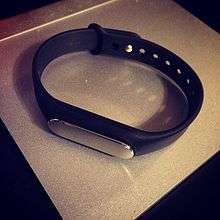Xiaomi Mi Band
 | |
| Developer | Xiaomi |
|---|---|
| Manufacturer | Foxconn |
| Type | fitness tracker |
| Release date | July 22, 2014 |
| System-on-chip used | Dialog SmartBond DA14580 |
| Connectivity | Bluetooth 4.0 |
| Power | 41.01 mAh |
| Online services | Google Play, F-Droid |
| Weight | 13 g (0.46 oz) |
| Successor | Xiaomi Mi Band 1S, Xiaomi Mi Band 2 |
| Website |
mi |
The Xiaomi Mi Band is a wearable fitness tracker produced by Xiaomi. Xiaomi Mi Band was unveiled during a Xiaomi launch event on 22 July 2014.[1]
Design
The Mi Band resembles a bracelet in its design, and can be worn on either hand, ankle or around the neck. The band's location can be set using the official Mi Band app called Mi Fit.
The band contains the core tracker which is around 9 mm thick, and 36 mm in length. It is inserted into a hypoallergenic TPSiV wristband, which has anti-UV and anti-microbal properties. The tracker is inserted into the charger module, which can be connected to a 5.0 V external power source. It is also called "Xiaomi Fit"
Specifications
- Fitness monitor & sleep tracker[2]
- Sleep-cycle smart alarm
- Unlock your Android without a password
- 30-day standby power
- Water resistant (IP67)
- 69RMB (approx. US$13 or ₹799) [3]
- vibrate alert(call & notification)
Software compatibility
At the time of launch, the only way to use Mi Band was to use the official Mi Fit app produced by Xiaomi themselves. As the protocol was successfully reverse-engineered,[4] independent companion software implementations were created by different enthusiasts. The most common free unofficial implementations for Android are Gadgetbridge [5] (that also supports Pebble devices and is focused on notifications more than on fitness purposes) and OpenBand [6] (focused solely on fitness and doesn't support notifications as of October 2015). All unofficial implementations that don't depend on Mi Fit app installed are missing some features official app has, such as OTA firmware update or ability to set different LED colors. Some unofficial companion programs were also written for other officially unsupported platforms such as BlackBerry 10 and Windows Phone.
Xiaomi Mi Band Pulse
Xiaomi, on 7 November 2015,[7] announced the successor of Xiaomi Mi Band. Xiaomi Mi Band 1s, is almost identical to its predecessor but the newer version includes a heart beat sensor, on the bottom side of the band. The new heart beat sensor, adds a little bit of bulkiness on the band as it now measures at 37 x 13.6 x 9.9mm. The addition of the heart beat sensor seems to have a small impact on the battery life as well. The company though, still promises 30 days of battery life.
Heart Rate is measured on demand, the 1S does not offer continuous monitoring.
References
- ↑ https://plus.google.com/+HugoBarra/posts/W1RAY3JZYRh
- ↑ "Xiaomi Mi Band, la Recensione di ZoomingIn".
- ↑ http://www.cnet.com/news/new-xiaomi-mi-band-will-cost-just-13/
- ↑ http://allmydroids.blogspot.com/2014/12/xiaomi-mi-band-ble-protocol-reverse.html
- ↑ https://f-droid.org/repository/browse/?fdid=nodomain.freeyourgadget.gadgetbridge
- ↑ https://play.google.com/store/apps/details?id=com.ugopiemontese.openband
- ↑ "Xiaomi Mi Band 1S is official; $15 device tracks your heart rate, quality of sleep and more". PhoneArena.com. Retrieved 2015-12-18.
External links
- Mi Band – Mi India
